Physical Address
304 North Cardinal St.
Dorchester Center, MA 02124
Amputation is no longer only the result of traumatic amputation or the real or perceived failure of limb salvage. Rather, amputation is now considered a viable and reasonable treatment option for extensively injured extremities and as such should be considered a reconstructive, rather than ablative, procedure. Amputation surgery has developed extensively since it was first recorded in Neolithic times, when the procedure was done in rudimentary fashion for trauma and disease and to “appease the gods.” Also gone, however, are the days when the amputation was done as a primary treatment for open fractures, as Larrey did in the Napoleonic Wars. Presently, amputations are done both urgently and electively to reduce pain, provide independence, and restore function. Presently, there are approximately 1.7 million individuals living in the United States with an amputation, or one of about every 200 people. The vast majority of lower extremity amputations are not caused by trauma but rather vascular insufficiency either due to peripheral vascular disease or diabetes in the elderly. About 80% of amputations are performed for complications related to vascular insufficiency. Upper extremity amputations, on the other hand, are most frequently the result of trauma in a young and otherwise healthy population; oncologic amputations accounted for approximately a third of amputations from 1988 to 1996. A smaller but significant number of amputations are done for congenital deficiencies, thermal trauma, and infections. Recently, the military has gained much experience with both performing amputations and improving prosthetic function. One of the primary lessons learned is that it is imperative to work as a team alongside general trauma surgeons, vascular surgeons, and plastic surgeons. After the residual limb is closed, close working relationships with rehabilitation physicians, prosthetists, and physical therapists, as well as psychiatrists and social workers, are essential to provide the patient with the best outcome.
When looking at amputations with regard to futile or failed limb salvage, there have been several attempts to quantify the damage done to a limb and establish prospective criteria or a scoring system for which limbs would benefit from early amputation versus limb salvage. To date, no system has been able to make this distinction reliably, with most systems showing that some patients with less severe injuries eventually go on to request an amputation even though the limb had been successfully salvaged from a surgical perspective. Factors that have been retrospectively associated with the need for amputation include vascular status, more severe classification of fracture, and severe soft tissue damage. However, no system has been able to adequately predict eventual amputation.
Three studies have shown that the functional outcomes of amputations and limb salvage are similar. First, the Lower Extremity Assessment Project (LEAP) studies have shown that patient-reported outcomes between limb salvage and amputations are similar at both 2 and 7 years after the traumatic event ( Table 72.1 ). Second, the Military Extremity Trauma Amputation/Limb Salvage (METALS) study demonstrated slightly better results in the amputation group with regard to patient-reported outcomes ( Table 72.2 ). Finally, the Naval Health Research Center did a study looking at the differences between amputation and limb salvage and found comparable outcomes for those undergoing limb salvage versus those undergoing amputation. One interesting thing they found was that those undergoing amputation greater than 90 days after injury had significantly higher rates of mental- and health-related diagnoses. They also found that early amputees had significantly reduced odds of important psychological outcomes, including posttraumatic stress disorder (PTSD) and substance abuse, than late amputees and limb salvage patients ( Table 72.3 ). All three studies, however, showed significant and persistent disability among patients with either limb salvage or amputation after severe extremity trauma. One downside to amputation as a treatment is the demonstrated greater permanent energy expenditure requirements for ambulation in a prosthesis versus normal control participants; however, comparative data are generally lacking for similar cohorts of limb salvage patients.
| LEAP Study | Amputation | Limb Salvage |
|---|---|---|
| SIP | 12.6 | 11.8 |
| RTW | 53.0% | 49.4% |
| METALS | Amputation (%) | Limb Salvage (%) |
|---|---|---|
| SMFA overall | 22.1 | 29.4 |
| SMFA mobility | 28.3 | 36.5 |
| SMFA emotional | 40.0 | 47.1 |
| VS | 44.4 | 25.2 |
| PTSD | 14.8 | 26.8 |
| NHRC | Early Amputation (%) | Late Amputation (%) |
|---|---|---|
| Osteomyelitis | 33 | 47 |
| Cellulitis | 25 | 40 |
| Nonhealing wound | 11 | 19 |
| PTSD | 19 | 33 |
| Substance abuse | 12 | 23 |
Regardless of the specific level or type of amputation, several principles should be adhered to when addressing either a traumatic amputation or a limb-threatening injury undergoing amputation. First and foremost, viable and functional residual limb length should be maintained whenever possible. Successful salvage of a functional joint level will generally result in improved function, and limb length should be determined by the ability of the residual or reconstructable soft tissue envelope to functionally support that level of amputation. One should neither sacrifice residual length to facilitate a conventional wound closure provided adequate soft tissue is available nor amputate at a more proximal level simply because of the presence of a proximal, otherwise manageable, fracture. Studies have demonstrated that residual limbs can still have excellent function with a terminal skin graft, provided otherwise robust soft tissue coverage is present. In some patients, even consideration of free tissue transfer may salvage a joint level, and some initial success has been seen with this approach. Similarly, stabilizing fractures proximal to an amputation has been shown to be successful in salvaging both residual limb length and amputation levels versus more proximal amputation through the fracture.
Once it has been determined that the extremity requires an amputation, it is important to consider what soft tissue of the amputated part can be salvaged to reconstruct the residual limb or another injured limb; often it can provide a valuable source of tissue. Spare parts surgery—where tissue that would otherwise be discarded with the amputated limb can be immediately used for reconstruction—has been described since 1947. One example includes harvesting skin graft from the amputated part to be used acutely for coverage of the residual limb or another soft tissue defect. If the “spare parts” cannot be used acutely, ectopic banking can be accomplished and then used when indicated. Ectopic banking of amputated parts has been described for over 30 years, commonly in the upper extremity. It was initially described in the upper extremity when primary replantation was not feasible due to patient status, contamination of wound, or sacrifice of length. It has since been described in cases such as banking a great toe from a transtibial amputation for eventual toe-to-thumb transfer in a patient with multiple extremity injuries ( Fig. 72.1 ). If banking is necessary, it is recommended to use the contralateral side for the banking due to the potential for multiple irrigation and débridements of the injured extremity requiring multiple tourniquet times as well as the ability to harvest additional length of artery or vein. It is something to consider if the necessity for amputation arises.
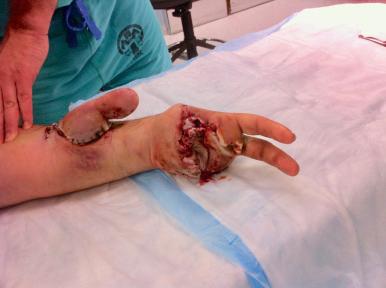
At the time of amputation, bone ends should be well padded with muscle and have sharp prominences removed to decrease the likelihood of late irritation or ulceration. In most instances, a good myodesis (suturing of the terminal muscle or tendon to the bone) should be done to both stabilize the padding and maximize terminal residual limb control. In upper extremity amputations in which a myoelectric prosthesis will often be contemplated, critical muscles groups should be individually myodesed into the bone so that the electromyographic (EMG) signal can be independently recorded without triggering involuntary antagonist muscle co-contraction. In this setting, myoplasty (suturing of antagonist or opposing muscles together) can confuse myoelectric signals and diminish prosthetic functionality.
Nerves should be transected proximally enough to allow them to be buried in muscle so that the inevitable neuromas are less likely to be painful and symptomatic. It is important to identify and transect all the nerves in an extremity, including superficial sensory nerves, because these are often identified at the time of symptomatic neuroma resection.
All major vessels should be individually ligated regardless of whether or not they have already thrombosed. Dual ligation with suture ligature and large-caliber silk ties is advocated for larger, proximal vessels to guard against catastrophic late hemorrhage or hematoma formation. Ligature clips, particularly for larger vessels, are generally discouraged in amputation surgery because they are subjectively less reliable than ties and can be a nidus for infection as well as cause pain. Management of the arterial ligature is usually best accomplished with a tourniquet in place. After all required muscle has been resected, the tourniquet should be let down before myodesis, myoplasty, and skin closure to ensure adequate hemostasis is achieved.
Amputation surgery has developed extensively and is now considered a viable and reasonable reconstructive, rather than ablative, procedure.
Approximately 1.7 million individuals with an amputation live in the United States.
About 80% of amputations are performed for complications related to vascular insufficiency.
The vast majority of lower extremity amputations are not caused by trauma.
Interdisciplinary cooperation (surgeons and rehabilitation physicians, prosthetists, physical therapists, psychiatrists, and social workers) is essential for good recovery and outcome.
An established, reliable prospective criteria set or scoring system for which limbs would benefit from early amputation versus limb salvage is missing.
Studies have shown the following:
Similar functional outcome of amputations and limb salvage, despite significant and persistent disability
Delayed amputation → significantly higher rates of mental- and health-related diagnoses.
Early amputation → significantly reduced odds of important psychological outcomes, including PTSD and substance abuse.
Functional residual limb length should be maintained whenever possible.
Length should not be sacrificed to facilitate wound closure provided adequate soft tissue is available.
A manageable fracture should not be a reason for a more proximal amputation level.
Salvage of a functional joint level provides improved function.
Consideration of free tissue transfer may salvage a joint level.
Bone ends should be padded with muscle, with sharp prominences removed to reduce irritation or ulceration.
Good myodesis provides stabilization of the padding with maximization of residual limb control.
Especially in upper extremity amputation and in regard to a myoelectric-controlled prosthesis, critical muscle groups should be considered (agonist vs. antagonist) concerning myoelectric signals and diminished prosthetic functionality.
Nerves should be transected proximally enough → buried in muscle → inevitable neuromas less likely to be painful and symptomatic.
Major vessels should be individually ligated.
Suture ligature and large-caliber silk ties are advocated for larger, proximal vessels
Clips are seen as a potential cause of infection and pain.
Amputation of an upper extremity is a catastrophic event primarily performed as the result of high-energy trauma in a young, otherwise healthy patient population. Upper extremity limb loss was estimated to account for 34% (541,000) of the 1.6 million people living in the United States with limb loss in 2005. Trauma accounted for 92% of hospital discharges because of upper extremity limb loss, of which 41,000 were proximal to the finger. Of the more than 1700 amputees, with a loss of nearly 2300 limbs, produced by the conflicts of the past decade, including Operation Iraqi Freedom and Operation Enduring Freedom, 17.3% have occurred in the upper extremity. There have been 17 service members with bilateral upper extremity amputations to date.
Although the surgical principles of upper and lower extremity amputations are similar, there are key differences in morphology and function that require special attention when considering an upper extremity amputation. The primary goal in lower extremity amputation is to provide a well-padded and durable residual limb that will allow for weight bearing, maximize ambulatory function, and minimize the energy consumption required for ambulation; the goal in the upper extremity is to maximize precision function and provide a cosmetic result. Knowledge of these differences and an awareness of the functional outcomes, prosthetic capabilities, and prosthesis acceptance rates associated with each amputation level are essential to ensure appropriate preoperative planning and to optimize patient outcomes.
The goals of amputation surgery in the upper extremity include the following: (1) preservation of functional length, (2) preservation of useful sensibility, (3) prevention of symptomatic neuromas, (4) prevention of adjacent joint contractures, (5) minimal and short morbidity, (6) early prosthetic fitting (when applicable), and (7) early return of patient to work and recreation.
An integrated team approach has been shown to improve amputee care. In addition to orthopaedic surgeons, additional specialties involved in the care of the upper extremity amputee include trauma surgery, physiatry, occupational therapy, physical therapy, anesthesiology and pain management, mental health, social work, nursing, and prosthetics. Involving the patient and family in the decision-making process is crucial to maximize functional and aesthetic outcomes in addition to patient acceptance of and satisfaction with outcomes. A multidisciplinary approach to care is essential for multiple extremity amputees, as frequently seen resulting from combat trauma, because numerous comorbid conditions are likely to be encountered, and the complexity of comprehensive treatment is greatest. Fortunately, good functional outcomes and prosthetic acceptance rates can be expected with a well-coordinated rehabilitation protocol and timely prosthetic fitting.
A mangled upper extremity has a far greater impact on the overall function of the individual than does a mangled lower extremity. Unfortunately, no reliable Injury Severity Score exists as a guide for treatment decision of amputation versus limb salvage. Although extremity Injury Severity Scores for the traumatized lower extremity have been developed (with variable clinical utility, as noted earlier), their application in the upper extremity has not been validated.
Anatomic and functional differences make the upper extremity more amenable to limb salvage or replantation than the lower extremity. Because the upper extremity is essentially non–weight bearing, length inequality is not a concern. This allows significant shortening of the limb to achieve primary vascular and nerve repairs and achieve soft tissue closure or coverage more readily. Results of nerve repair and reconstruction are more successful in the upper extremity than the lower extremity. Decreased muscle mass in the upper extremity also decreases the risk of crush or reperfusion syndrome. In addition, increased collateral circulation in the upper extremity may allow for reperfusion times to be extended to 8 to 10 hours after critical vascular injury. General indications for replantation in the upper extremity include loss of the thumb, loss of multiple digits, amputation proximal to the palm, and any amputation in a pediatric patient. Relative contraindications to replantation include crush injury, avulsion injury, severe contamination, single digit loss in zone II, segmental injuries, and prolonged warm ischemia time ( Box 72.1 ). If the decision is made to perform a revision amputation as opposed to replantation, photographic documentation of the residual limb and the amputated part should be obtained due to the potential for litigation regarding the decision not to replant.
Loss of the thumb
Loss of multiple digits
Amputation proximal to the palm
Amputation in a pediatric patient
Crush injury
Avulsion injury
Severe contamination
Single digit loss in zone II
Segmental injuries
Prolonged warm ischemia time
A major consideration in upper extremity amputation is the dramatic difference in functional capability of even modern prostheses when compared with the normal hand. Despite dramatic improvements in prosthetic technology in the past decade, the numerous degrees of freedom of the human arm and the dexterity and sensory feedback of the hand are still only partially replicated with current prosthetic technology. For this reason, the adage “a bad hand is more functional than a good amputation” remains relevant to the treating surgeon and is likely the reason few will request late amputation after initial limb salvage of the upper extremity.
In general, superior functional outcomes can be expected in replanted limbs compared with upper extremity amputations, especially when there is the expectation for preserved hand prehension. This concept must be counterbalanced by the expectation for diminishing outcomes with attempts at higher level replantation, especially above the elbow. However, replant attempts above the elbow in the past have resulted in limb salvage at a more distal amputation level than would otherwise be expected.
Maximum preservation of length is desirable in the upper extremity amputee. With increasing length and preservation of joints, the amputee becomes more capable of positioning the terminal extremity or prosthetic device in space, allowing for the greatest functional result and leading to improved outcomes. As a transradial amputation moves more proximally, the ability to pronosupinate the forearm decreases. In the setting of traumatic amputation, the scope of injury often determines the level of amputation. However, it is important for the surgeon to understand the requirements and capabilities of prostheses for each amputation level and therefore direct opportunities for limb length preservation when available.
When residual tissue flaps are inadequate to provide distal amputation coverage and shortening will diminish prosthetic fitting and functional outcomes, options for additional soft tissue coverage, including skin grafts and free tissue transfers, should be strongly considered. This is perhaps most important in shoulder and elbow joint preservation but is also important when optimizing the length of the transhumeral and transradial amputee. Use of microvascular free tissue transfer in well-selected patients to maximize length and provide durable soft tissue coverage has proven successful in upper extremity amputations ( Fig. 72.2 ). Indications for free tissue transfer include (1) shoulder joint preservation by preserving a transhumeral amputation level, (2) elbow joint preservation, and (3) preservation of bone greater than 7 cm below the shoulder or elbow. Relative indications include wrist joint preservation and skeletal preservation between 5 and 7 cm below the shoulder or elbow ( Box 72.2 ). Although upper extremity amputations requiring skin grafts or flaps will take longer to heal, the functional benefits of joint or length preservation will usually outweigh any delays in rehabilitation and prosthetic fitting ( Figs. 72.3 and 72.4 ).

Shoulder joint preservation (salvage of transhumeral amputation)
Elbow joint preservation
Preservation of greater than 7 cm bone distal to shoulder (humeral length)
Preservation of greater than 7 cm bone distal to elbow (ulnar length)
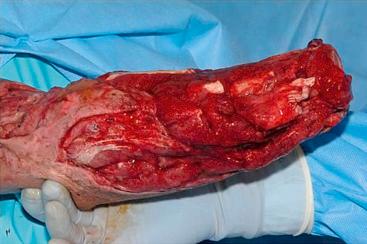
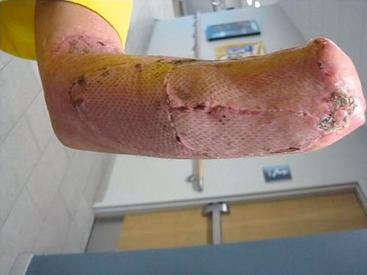
Careful attention to nerves and muscles is critically important in the upper extremity amputation because symptomatic neuromas are common. Before final closure of amputation in the upper extremity, all named sensory and motor nerves should be identified. All motor branches to muscle flaps within the operative field should also be preserved to prevent denervation, with resulting loss of muscle mass for limb padding and possible loss of sites for the myoelectric signal. However, all nerves should undergo gentle traction neurectomy to locate neuromas away from the distal amputation myodesis or skin closure. Whereas more aggressive traction neurectomies of large peripheral nerves with motor function were recommended in the past, preservation of additional nerve length, while still preventing more distal exposure of neuromas, can reserve the future ability to perform targeted muscle reinnervation (TMR), a technique to enhance myoelectric prosthetic control (discussed later in this chapter).
Stabilizing the muscle–tendon units of the residual limb under physiologic tension at the time of amputation closure serves two main purposes. First, it serves to provide robust coverage over the distal bone end, providing comfortable padding for the prosthetic socket while preventing the formation of painful bursa formation from mobile muscle units. Second, optimal contractility characteristics of the muscle are preserved, improving muscle signal quality and maximizing myoelectric prosthesis control while also maximizing terminal residual limb control for body-powered prostheses. Myodesis, the process of attaching muscle–tendon units directly to bone, is the surgical technique that provides the most stable construct over the distal bone end. This is typically achieved by suturing the muscle, tendon, or both to the bone end, usually through drill tunnels or, less commonly, to periosteum. Myoplasty, attaching agonist muscles to antagonist muscles over the bone end to create physiologic tension, and myofascial closure, or suturing of muscle and fascia together, are less stable constructs that may be indicated when myodesis cannot be achieved, for secondary muscles after primary myodesis is performed, or to contour remaining muscle bellies before closure. Although there are no data in the literature to support the superiority of myodesis over myoplasty, myodesis is recommended in upper extremity amputations to provide the most stable limb and to best isolate muscle signals and myoelectric prosthetic control.
The mangled hand is a common traumatic injury in young individuals, most commonly occurring from agricultural, industrial, household, and motor vehicle accidents, as well as combat-related injuries ( Fig. 72.5 ). According to the American Medical Association (AMA) Guidelines to the Evaluation of Permanent Impairment, the thumb accounts for 40% loss of the function of the hand and 25% loss of whole body function, with the loss of the index through small fingers causing less disability. However, the ring and small fingers are considered vital for grip strength and power grasp as would be critical in young laborers and military service members. More proximal amputation levels should be discouraged if preservation of basic prehensile function with two sensate digits able to oppose each other can be accomplished. However, a more stable terminal pinch can be expected with preservation of the thumb and at least two additional digits. Although outside the scope of this chapter, the decision to perform digital or radiocarpal salvage versus amputation can be difficult; there is currently no specific algorithm or digit scoring system to guide the surgeon. Although avulsion injuries remain a relative contraindication to replantation, in select cases of radiocarpal amputations, replantations have been successful. As a result, consultation with an upper extremity specialist is highly recommended, if available. Surgeon experience, a patient-centered approach to treatment, and multispecialty consultation all help guide decision making.
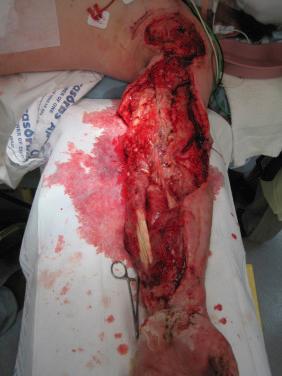
Amputations through the carpus present a special consideration. Reconstruction to allow pinching and grasping are not practical at this level. Consideration can be made to revise the amputation to a wrist disarticulation or transradial level to permit greater prosthetic functionality. However, if the radiocarpal joint is preserved, consideration can be made to salvage a transcarpal level when soft tissue coverage is available. The advantage of this level is the long limb that may allow functional use for rudimentary tasks or to assist a contralateral normal limb, without the need for prosthetics. Also, in maintaining the distal radial ulnar joint, full forearm pronosupination is maintained, and there is no risk of painful impingement of the distal radius and ulna. The perceived disadvantage is the same as that for wrist disarticulation; historically, this level has been difficult to fit with a highly functional prosthesis compared with the transradial level. However, this may be changing with advancing prosthetic technology, and therefore, consultation with a prosthetist, when feasible, is recommended before deciding on the final amputation level.
The advantages of the wrist disarticulation level amputation include: (1) full forearm rotation is preserved when the distal radioulnar joint (DRUJ) is preserved, (2) there is no risk of impingement or abutment of the distal radius and ulna as sometimes seen in transradial amputations, (3) the large surface of the distal radius can allow weight bearing through the terminal end, (4) the long sensate residual limb increases functional length, and (5) it is a better platform for prosthetic fitting. The main disadvantage, historically, has been limited prosthetic options because of the very short working length of and space available for the terminal device while attempting to achieve an acceptable limb length and cosmetic result. A survey of US surgeons conducted by Tooms in 1972, before the introduction of modern wrist prostheses, indicated a preference for distal transradial amputations over wrist disarticulations. However, more recent advances in prosthetic design and materials have greatly improved function for wrist disarticulation amputees. It may thus be helpful to consult with an upper extremity prosthetist when a decision must be made to preserve a wrist disarticulation level or to revise to a transradial level. Additionally, the advent of vascularized composite tissue allotransplantation, or hand transplantation, may prompt additional consultation with a center performing this procedure when considering definitive wrist disarticulation.
Successful amputation at the wrist disarticulation level requires a healthy and intact DRUJ. Preservation of the triangular fibrocartilage complex and radioulnar ligaments will allow for stable pronation and supination. Every attempt should be made to use the thick palmar skin of the hand for distal coverage, but often skin flaps for final wound closure are dictated by the injury. Although the radial styloid should be saved for prosthetic suspension, it can be contoured to prevent prominence and prevent prosthetic interface skin irritation or breakdown. It is crucial to perform a myodesis of the flexor and extensor tendons to maintain tension in those muscles that will provide necessary myoelectric prosthesis function; this is usually done by suture attachment of tendons through drill tunnels or at least suturing them to residual radiocarpal capsule and ligaments. The radial and ulnar arteries are double ligated, and large veins also usually require ligature. Important nerves to address include not only the median and ulnar nerves but also the superficial radial nerve, the palmar cutaneous branch of the median nerve, the dorsal ulnar cutaneous nerve, and possibly the terminal median and lateral antebrachial cutaneous nerves. These named nerves should be divided proximal to the level of amputation closure by gentle traction neurectomy and buried under muscle to prevent the development of a painful neuroma. An exception is the preservation of cutaneous nerves to a skin flap required for distal amputation coverage.
The transradial amputation is the most common upper extremity amputation. This level of amputation also has the highest prosthetic acceptance rates in the upper extremity. In distal transradial amputations, the long lever arm, available forearm rotation, and preserved shoulder and elbow allow the terminal prosthetic device to be easily positioned in space. The transradial amputation level is also cosmetically appealing because of the ability to fit body-powered or myoelectric prostheses with quick-disconnecting components while still maintaining equal limb lengths. The transradial amputation level is a possible candidate for hand transplantation (discussed later in this chapter), as well as a potential candidate for targeted reinnervation technology, so additional consultation with transplantation centers or prosthetists and centers performing targeted reinnervation are currently warranted.
When practical, at least two-thirds of the forearm should be maintained. Removal of 6 to 8 cm of bone is recommended to offer a robust soft tissue envelope and permit a wide variety of prosthetic options ( Figs. 72.6 and 72.7 ). Consideration for soft tissue interposition between the radius and ulna should be made to decrease the potential for painful convergence and instability. This is generally accomplished with the pronator quadratus for more distal amputation levels, and more proximally, it can be performed by one interposed extensor and flexor tendon. Nerves are managed as for the wrist disarticulation amputation; ensuring motor branches to muscles for myodesis are preserved will maximize myoelectric prosthesis function.
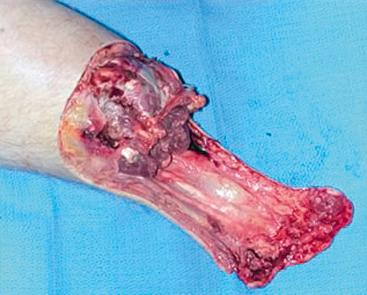
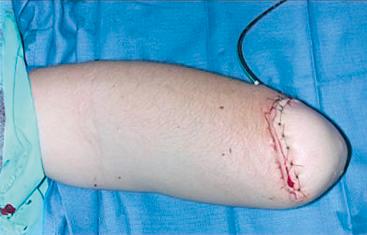
Residual ulna length of at least 5 cm is required to allow for prosthetic fitting and elbow motion. However, useful pronation and supination are not generally preserved when the amputation level must be in the proximal third of the forearm and may affect the use of a body-powered prosthesis ( Fig. 72.8 ). At this proximal level, consideration should be made to transfer the distal biceps tendon to the proximal ulna. The obvious prosthetic and mechanical advantages of the transradial level coupled with the superior prosthetic acceptance rates should prompt the surgeon to consider all reconstruction options, including free tissue transfer, to preserve an amputation at this level.
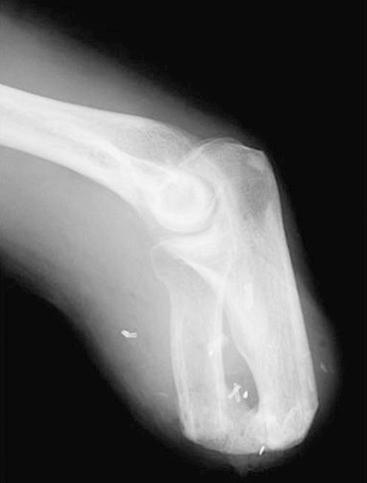
Elbow disarticulation and distal transhumeral amputations are functionally quite similar, maintaining a flare to the distal humerus that allows improved suspension and improved rotational control of a prosthesis compared with more proximal amputation levels. The major disadvantage of this level is the cosmetic appearance of length inequality with the prosthetic elbow joint distal compared with the contralateral normal elbow or with the center of rotation placed lateral to the axis of the humerus to minimize the length inequality. However, the improved suspension and rotational control usually outweigh any cosmetic concerns for most patients. Consideration can be made for a (generally delayed or elective) shortening osteotomy of the humerus to improve the cosmetic result, but this is rarely indicated or performed. Consultation with the prosthetist and discussion with the patient help guide whether to preserve the elbow disarticulation level or to resect to a more proximal level.
Although a posterior-based flap provides excellent coverage when available, the injury will usually dictate the skin flaps available for closure. Consideration for additional bone resection can usually be made to ensure a robust myodesis of the elbow flexor and extensor tendons and muscles and a well-padded covering over the distal bone end. Residual flexor and extensor origin muscles can provide additional coverage of the distal humerus after primary myodesis is performed. Split-thickness skin grafts (STSGs) are usually well tolerated at this amputation level, and consideration for the use of a dermal substitute before final skin grafting improves the durability of the skin–socket interface. Proper nerve management remains critical; careful identification of the median nerve, radial nerve, ulnar nerve, medial and lateral antebrachial cutaneous nerves, and usually small posterior cutaneous nerves followed by gentle traction neurectomy proximal to the myodesis will limit the development of painful neuromas.
If the condyles of the distal humerus are not preserved, the ideal level for amputation is approximately 4 to 5 cm proximal to the elbow joint. Adequately suspended and standard prosthetic components are expected at this level, but rotational control is decreased compared with the elbow disarticulation. Anterior angulation osteotomy, described by Marquardt in 1972, can be performed to the distal humerus to allow a rotation-stable prosthesis and a free-moving shoulder. The osteotomy is generally angulated 70 degrees anterior, and fixation with either interfragmentary screw fixation or a compression plate and screw construct is performed ( Fig. 72.9 ).
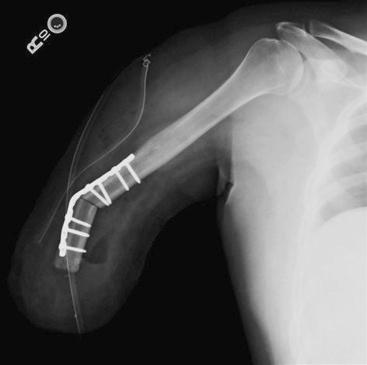
In the proximal transhumeral amputation level, maintenance of length is critical, with most sources recommending preservation of at least 5 to 7 cm of length from the glenohumeral joint to preserve reasonable function. At this proximal level, however, prosthesis fitting is difficult, resulting function is limited, and prosthesis rejection rates are increased. As in the transradial amputation level, use of dermal substitutes, skin grafting, and local and free flaps are strongly considered to preserve adequate length. Preservation of the deltoid, pectoralis major, and latissimus dorsi insertions to the humerus allows for both body-powered and myoelectric prosthesis control. The brachial artery and veins are identified and double ligated, and gentle traction neurectomy is performed to the median, radial, and ulnar nerves. Myodesis of the triceps, biceps, and coracobrachialis is made to the distal bone end through drill tunnels.
Amputation proximal to these named tendon insertions will functionally result in an amputation at the shoulder disarticulation level. In such instances, preservation of the humeral head, if possible, will improve body contour and the cosmetic result and may aid in force transmission. Unless stabilizing myodesis can be performed with available muscles, the unopposed pull of the rotator cuff muscles may cause painful or disfiguring abduction contracture or subluxation ( Fig. 72.10 ). As a result, glenohumeral arthrodesis, often as a planned, staged procedure, is strongly recommended ( Fig. 72.11 ). If present and viable, a deltoid-based flap for coverage is recommended after shoulder disarticulations.
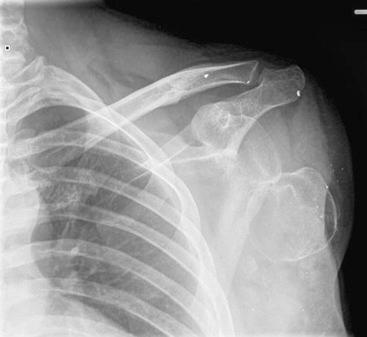
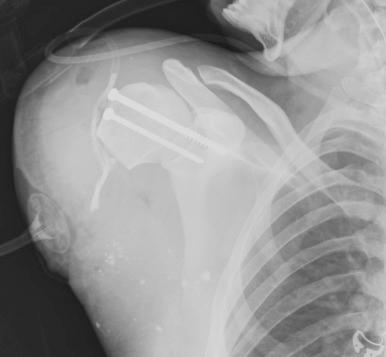
Trauma-related shoulder disarticulations and forequarter amputations are both exceedingly rare. The injuries themselves, or devastating associated injuries, are often fatal before the patient can reach medical care. Shoulder disarticulation is much preferred in terms of both prosthesis suspension and potential function as well as improved cosmesis; however, both levels represent amputations of last resort. Forequarter amputation may be indicated in the setting of a complete or near-complete traumatic shoulder disarticulation with inadequate soft tissue coverage to maintain that amputation level in a patient unable to tolerate advanced soft tissue coverage procedures and/or a concurrently degloved scapula. Although originally described in 1808 for a traumatic injury resulting from a gunshot, it is more common with regard to oncologic surgery as opposed to a traumatic setting. In these rare instances, the priority is saving the patient's life. It is necessary for proximal vascular control with ligation of the subclavian artery and vein early in the case. Residual nerves of the brachial plexus should be buried underneath the residual clavicle, if present, or tucked behind the first rib. Soft tissue coverage and closure are achieved by whatever means available because local options are generally quite limited.
The loss of one or both upper extremities is a devastating event. The loss of prehensile function and sensation is currently not adequately replaced by modern prosthetic technology. Prosthetic acceptance rates are frequently discussed as an outcome measure, although there is little high-quality evidence in the literature, and what is available is now dated, particularly in light of recent upper extremity prosthetic and surgical advances.
Rejection rates in upper extremity amputations are frequently reported to be 21% to 38%, with larger studies typically reporting more than 30% rejection. When excluding cosmetic prostheses, the rates are probably higher. High rejection rates have been loosely associated with poor training, delayed prosthetic fitting, and proximal amputations. A 1995 survey of upper extremity amputations cited limited usefulness, increased weight, and residual limb socket discomfort as primary reasons for prosthesis rejection. Factors associated with increased prosthetic acceptance include loss of the dominant extremity, absence of pain in the residual limb, and early prosthetic fitting within 30 days of amputation.
It is generally accepted that prosthetic acceptance rates are directly correlated with the level of amputation, with increasing utilization for progressively more distal levels of amputations, and this correlates with higher functional scores. The transradial amputation level also has the highest reported acceptance rates, which range from 80% to 94%. This is followed by transhumeral amputation, ranging from 43% to 83%. As expected, shoulder disarticulation is associated with the lowest reported prosthetic acceptance rates. Increased prosthetic weight and complexity, decreased prosthetic functionality, and difficulty with prosthetic suspension easily explain decreasing prosthetic acceptance rates with higher levels of amputation and illustrate the willingness of many patients to function with only one upper limb rather than use a burdensome prosthetic device. Two unique situations warrant mention. In those with bilateral upper extremity amputations, at least one limb will use a prosthesis. In patients with an ipsilateral brachial plexus injury, prosthetics will almost universally be rejected.
Most people who have undergone an upper extremity amputation are able to return to work, although one-half to two-thirds will change their occupation to accommodate for the loss of the limb. Patients with a transradial amputation have the highest rates of return to work. In the military population, fewer are able to return to an active-duty status, with a range of 14% to 16.5% overall return-to-duty rate noted during the most recent conflicts.
Chronic pain is a frequent complication of traumatic upper extremity amputations. The prevalence of pain in the residual limb after upper extremity amputation is reported in 7% to 49% of patients. Phantom limb pain is reported in 30% to 79% of upper extremity amputees, with most authors reporting greater than 50% prevalence. Despite this, chronic pain has not been shown to significantly impact functional prosthetic wear or return to employment as one might expect.
Acute pain management requires a multidisciplinary approach and early consultation with pain management specialists to facilitate timely rehabilitation and limit or prevent chronic pain complications. Phantom limb pain is common after traumatic upper extremity amputation. Although upper extremity data are not available currently, Hanley and colleagues demonstrated that postoperative pain and acute pain predict chronic pain in lower extremity amputations. Aggressive pain management with a multimodal pharmacologic approach; the use of adjuncts such as injection therapy; and complementary and alternative approaches such as desensitization programs, biofeedback, relaxation techniques, acupuncture, and hypnosis optimize outcomes in amputation patients. Evidence, predominantly in the lower extremity amputation literature, also supports the use of perioperative epidural and perineural analgesia with indwelling catheters to reduce chronic and phantom limb pain but recommends that this treatment begin early, at least 24 hours before amputation.
In addition to phantom limb pain, pain caused by neuromas is a frequent source of upper extremity limb pain and a frequent reason for amputation reoperation. This underscores the requirement for careful management of nerves during amputation surgery. Although gentle traction neurectomy is recommended to ensure that eventual neuromas are proximal to the incision line and the distal myodesis, careful exposure of nerves and the use of the technique of burying the nerve end in muscle may be required. Painful neuromas can be managed with revision surgery for neuroma excision and/or TMR, as discussed later.
It is common for upper extremity amputees to experience pain in other locations, with back pain; neck pain; and most important, pain in the contralateral, uninjured extremity. Such pain has been reported in rates higher than seen in the general US population. This can lead to significant morbidity and lost workdays and highlights the importance of educating new patients with amputations about overuse injuries.
Additional complications in upper extremity amputations include infection, myodesis failure, joint contractures, and heterotopic ossification (HO). In the combat-related upper extremity amputation population, infection is the most frequent indication for reoperation, with Tintle and colleagues reporting an incidence of 51% in their series of upper extremity amputations requiring reoperation. A high incidence of symptomatic HO requiring revision was also reported (19%), with painful neuromas (9%), joint contractures (4%), and scar revisions (5%) making up the remaining indications for reoperation ( Fig. 72.12 ). It is also important to note that within the revision cohort, there was an increase in prosthetic use from 19% to 87% after the revision.
Result of high-energy trauma in a young, healthy patient population
More amenable to limb salvage or replantation than the lower extremity
Results of nerve repair and reconstruction are more successful.
Collateral circulation allows for reperfusion times to be extended to 8 to 10 hours.
Loss of the thumb
Loss of multiple digits
Amputation proximal to the palm
Any amputation in a pediatric patient
Avulsion injury
Crush injury
Severe contamination
Single digit loss in zone II
Segmental injuries
Prolonged warm ischemia time
Preservation of functional length
Preservation of useful sensibility
Prevention of symptomatic neuromas
Prevention of adjacent joint contractures
Minimal and short morbidity
Early prosthetic fitting, when applicable
Early return of patient to work and recreation
The loss of prehensile function and sensation is currently not adequately replaced by modern prosthetic technology.
Prosthetic acceptance rates are discussed as an outcome measure.
More than 30% rejection is reported
Correlation with level of amputation
High rejection rates → poor training, delayed prosthetic fitting, proximal amputations
Increased prosthetic weight plus complexity, decreased prosthetic functionality plus difficulty with prosthetic suspension → decreasing prosthetic acceptance rates
Factors associated with increased prosthetic acceptance → loss of the dominant extremity, absence of pain in the residual limb, early prosthetic fitting
Most people with amputations are able to return to work.
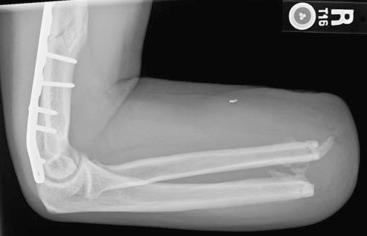
Become a Clinical Tree membership for Full access and enjoy Unlimited articles
If you are a member. Log in here